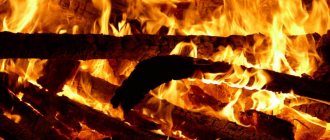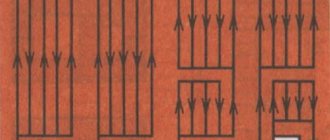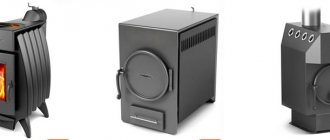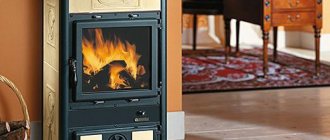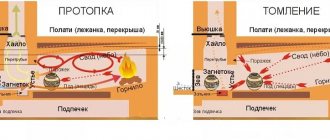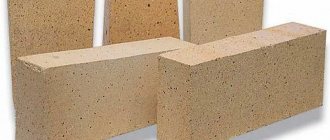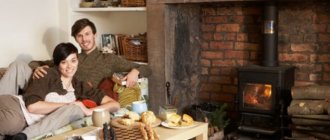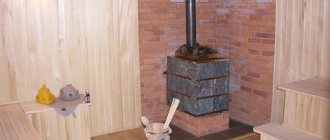Not long ago, an alternative fuel for lighting stoves appeared - fuel briquettes, which are positioned as an analogue of conventional firewood, but with better calorific characteristics. In order not to be unfounded, we decided to compare the capabilities of wood and European firewood, evaluate their technical characteristics, nuances of use and determine whether fuel briquettes or firewood are better for the consumer, which is more profitable.
Comparing firewood and fuel briquettes
Fuel briquettes or firewood – which is better?
It is advisable to start comparing different types of fuel with the cost of materials. If we analyze their price indicators, 1 m3 of Euro firewood will cost approximately twice as much as the same amount of ordinary logs. Moreover, the former are made from raw materials of varying value; the price of firewood is determined by the type of wood.
There are different products on the market. First-class briquette products have a denser structure, do not contain cracks or chips, and most often they are fired on the outside. Low-quality products are multi-layered, have lower density, and are vulnerable to mechanical damage. Such fuel burns faster and produces less heat.
The cost of fuel briquettes is approximately twice as much as regular firewood Source pankornik.pl
Advantages of firewood compared to briquettes
- A major advantage of briquettes compared to firewood is their ability to generate stable heat over a longer period of time. Although the heat intensity is less than when using firewood. Therefore, if you want to quickly warm up the room with European wood firewood, as with ordinary wood, then you will not succeed.
- People who are used to spending the evening with a book or a cup of strong tea by the fireplace will most likely be disappointed. This fuel will not be able to please them with the crackling characteristic of ordinary firewood, which creates that unique feeling of home warmth and comfort. With the help of classic firewood, it is very easy to obtain the necessary “sound accompaniment”, since they contain water, but briquettes do not have it.
- When using Euro firewood, you will have to put up with the unpleasant smell of ash. Ordinary firewood will not give you such an unpleasant surprise, since wood ash does not emit a tart odor.
- Fuel briquettes, which are offered in stores today, are a rather fragile product that easily turn into crumbs. If you do not want to lose precious fuel before your eyes, then you should choose strong, high-quality briquettes.
Now it has become a little clearer about the advantages that firewood and fuel briquettes have. It remains to get an answer to one more question that worries many owners - which fuel is the most economical?
What to choose: coal or firewood?
Coal is perfect for heating boilers located in a separate room. It is not at all recommended to use it in a stove located in the home. This is due to the fact that such fuel burns for a long period and does not burn completely. For this reason, it is unacceptable to leave the chimney closed so that carbon monoxide does not accumulate in the room. At the same time, ordinary firewood always burns completely, releasing enough heat. This means that you can safely close the valve without fear for your health or heat leakage through the chimney.
Lighting charcoal without the right wood is a difficult task. Therefore, all those who use it are forced to purchase material for ignition.
Coal dust is considered quite harmful to human health. When throwing such fuel into the stove, you must try to prevent dust from rising into the air. Firewood contains almost no dirt, making it much safer.
As opposed to coal heating, traditional wood heating is more environmentally friendly: when burned, dry wood emits a small amount of carbon dioxide and therefore does not damage the natural environment. The latter is not typical for coal.
Unlike firewood, coal is not recommended for heating stoves located in residential premises Source tektarif.ru
Charcoal briquetting
When producing charcoal, about a quarter of it turns out to be substandard - small pieces and dust. To turn this waste into income, you can make briquettes from them. Charcoal briquettes can also be made at home; if necessary, you can make raw materials for this (charcoal yourself). The principle of briquetting charcoal is no different from the formation of the same fuel from coal:
- Substandard coal is crushed.
- Mix with binder. In this case, a regular starch paste will do the job well. The output should be a slightly moist mass. Some of the dust rolls into small lumps.
- The resulting mixture is fed into a press, where briquettes are formed.
This video clearly shows the entire technology of charcoal briquetting, but the guys created a form specifically for the customer (church tablets made from charcoal for incense were ordered). Similarly, you can make a mold of any configuration.
Conclusions. Briquettes from coal crumbs and dust (stone and wood) can be made at home. It is difficult to achieve commercial results (only through automation, and therefore expensive equipment), but for home use it is possible to make a simple installation.
How to make briquettes with your own hands
If firewood or briquettes are not available, you can try to make the latter yourself. The main principle of Euro-firewood production is the compression of crushed wood waste until lignin begins to be released. This substance subsequently glues small particles into a monolithic product. For the production of fuel briquettes it is allowed to use: agricultural residues, sawdust, shavings, and other woodworking waste.
Procedure:
- Grind raw material.
- Dry to 10% moisture content.
- Using a hydraulic press or auger device, briquet the prepared raw materials.
Varieties
Fuel briquettes differ in the material that is the main one in their production and the technology underlying their production.
The raw materials for fuel briquettes are:
- various wood of all species - shavings, sawdust, branches;
- dust and fine fraction of hard and brown coals;
- agro-industrial waste - straw, sunflower husks, buckwheat, rice;
- peat.
Let's consider the main technical characteristics of fuel briquettes made from various raw materials.
| View | Heat transfer, kW/kg | Humidity, % | Ash content, % | Approximate price for 1 ton, c.u. |
| Wood briquettes | 5,2-5,8 | up to 12 | 1 | 102 |
| Coal briquettes | 7,55 | 10-15 | 12 | 150 |
| Brown coal briquettes | up to 5 | 10-15 | up to 30 | 70 |
| Eurofirewood made from sunflower husks | 4,5-5 | 10 | 5 | 79 |
| Straw briquettes | 4,8-5,2 | 10 | 4 | 65 |
| Peat briquettes | up to 4.5 | before 18 | 20 | 90 |
Fuel briquettes should be stored in a well-ventilated area where there is no free access to moisture. In the summer, briquettes cannot be stored on the ground without being separated by a film from below from evaporation from the soil, since moisture condenses on the packs of briquettes at night. Therefore, on the bottom of the pallet under the packs it is necessary to arrange a hermetically sealed insulation from the ground, for example, you can use plastic film.
You can read about the features of fuel briquettes from manufacturers Ruf, Pini Kay, Nestro and Nilson here.
Simple cylindrical briquettes
This is the most common type of fuel briquettes, made in the form of cylinders. Sawdust and small wood waste are used as manufacturing materials. All this is pressed under low pressure using a non-toxic adhesive base. After this process is completed, the finished briquettes are put up for sale. Such fuel is inexpensive, but cannot boast of high strength. They tolerate moisture very poorly, crumble and fall apart.
Sunflower fuel briquettes
Fuel briquettes from coal and peat
Based on the name, it becomes obvious that coal and peat are used to create such fuel briquettes. Coal and peat briquettes are used for lighting stoves and solid fuel boilers. Fuel made from coal has a high combustion temperature, but it also produces a large amount of ash.
Fuel briquettes from coal
Questions and answers
Do fuel briquettes contain binding components harmful to human health?
No binding components are used in the production of fuel briquettes. The strength of the products is ensured by the ligin contained in wood and plant materials. Under the influence of high temperatures and pressure, it melts and does not pose a danger to human health.
How long does Eurowood burn?
The duration of burning of Eurowood depends on the conditions in which this process takes place. When burning briquettes with a constant supply of oxygen, the process can last approximately 0.5-1.5 hours, without oxygen - 4 hours.
What is the weight of pini-kei fuel briquettes?
With a density of 1.08-1.36 g/cm3, one cubic meter of fuel briquettes of this type can weigh 1080-1360 kg. This is significantly more than ordinary firewood. At natural humidity of 20%, a cubic meter of oak weighs 800 kg, birch - 750 kg and pine - 520 kg.
Which fuel briquettes are best to choose for heating a bath?
For sauna stoves, briquettes of the RUF type are most often used.
What volume of firewood can replace 1 ton of fuel briquettes?
One ton of fuel briquettes can replace 4-6 m3 of ordinary firewood.
Coal for a good boiler
The combustion temperature of hard coal can reach 1400o C, the ignition temperature is 600o C - these properties are used when conducting energy-intensive processes in ferrous and non-ferrous metallurgy, where hard coal and anthracite are traditionally used. The combustion of coal (brown) is accompanied by increased heat transfer to heat metals up to 1200o C. At the same time, studies show that when coal burns, up to 40% of volatile gases are released, and after their combustion, up to 14% of ash remains.
Coal briquettes for heating have significantly lower values for these indicators, while maintaining high combustion heat characteristics (up to 5500 kcal). Briquette is a compressed mixture of crushed coal fractions and fixative fillers with a density of 1.4 g/cm3. High calorific value and the absence of coal dust have made coal in briquettes a popular type of fuel used in private households and in enterprises where there is no centralized heat supply. Coal slag, formed during the combustion of fuel, can serve as fertilizer for plants in the area adjacent to the house.
What fuel should I use in my stove?
An important factor for maintaining a constant temperature is the correct choice of long-burning stoves, which are refueled periodically and the fuel in them burns much longer. Owners of country houses or summer cottages can use artificial firewood to heat their premises, but it is convenient to use briquettes to light a fireplace. To do this, it is better to place them on paper and birch bark, which will speed up the ignition process. In the same way, you can use firewood, which does not always light well. To prevent soot from remaining as sediment in the chimney, it is recommended to throw a pinch of table salt into the fire with each addition.
How much are?
The price of briquettes for heating a furnace depends on the technology and material from which the product is made.
- Alternative fuel of the Pini-kay type made from pine needles will cost an average of 8,900 rubles. for one ton, from birch - from 9,500 rubles.
- RUF briquettes are cheaper: sawdust 6500, pine needles 6000, pine and birch 6500, birch 6900 rubles.
- Nestro briquettes are the most inexpensive: 7500 per ton. Peat briquettes will cost the stove owner 8,000 rubles, and coal briquettes – 9,500 rubles.
You can purchase briquettes in specialized stores, as well as on websites on the Internet. Online shopping will be a little more profitable, since you will not have to pay for the services of consultants and renting store premises. But in the store you can personally see the quality of such a purchase, which is very difficult to do via the Internet.
Manufacturing technology and scope
After processing natural raw materials, a large amount of waste remains. For example, in the woodworking industry these are shavings, sawdust, and wood chips. Each production strives for a waste-free operation scheme, so they have long learned to use even leftover raw materials to make the necessary products, for example, chipboard. With the rise in price of solid fuels, waste began to be pressed into briquettes that were convenient for use and transportation - and they immediately became in demand.
The technology for making wood briquettes for heating is simple: the waste is crushed, pressed, and simultaneously subjected to heat treatment. To bind particles together, the natural component lignin or synthetic solutions are used. Lightly melt the surface to maintain its shape.
To increase combustion efficiency, some types have through holes. Then small-sized products are packaged in film or paper bags; more protected briquettes are left unpacked. In this form, the products are sold for private and industrial needs.
When purchasing briquettes at retail or, which is much more profitable, wholesale, pay attention to the shape and size - they must match your boiler, stove or barbecue
The heat transfer of the fuel is sufficient for it to be successfully used for heating completely different rooms, such as:
- production workshops, warehouses with an area of up to 200 m²;
- utility rooms, boiler rooms;
- private properties: cottages, country houses, dachas;
- Russian baths, saunas.
Small-sized briquettes and granules can easily be placed in stoves of any size; for volumetric solid fuel boilers, “eurowood” of increased length or diameter is provided. One example: 30-35 kg of sawdust fuel is needed per day to heat a large warehouse hangar with an area of 180-200 m², that is, 3-3.5 standard ten-kilogram packages will be needed.
Light and compact briquettes are convenient for transportation in the trunk of a car, they burn well in the open air, so lovers of outdoor recreation prefer to take them with them for making fires, barbecuing or cooking on the grill. For summer residents, briquetted products are a universal means - they are successfully used both for heating houses and for starting a fire on the site.
